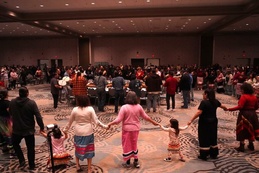Hunger in the Land of Plenty
Nov. 28, 2010
Hunger in the Land of PlentyThanksgiving is an excessive delight for most of us. Family,
friends and food in overabundance.
Many of us do a good deed by contributing to a food bank or helping
serve a real Thanksgiving Day dinner to people less fortunate. It
gives us a justifiably good feeling about ourselves and helps lift up,
at least temporarily, people who need it.
Days later we’ve finally finished off the last of the leftovers and
the more industrious households have made a nice turkey stock from the
carcass. The people we helped on Thanksgiving might not have had
another decent meal since.
Hunger in the United States is our dark secret, a reality whose
name we apparently dare not speak. Politicians certainly don’t talk
much about it and do even less. The media doesn’t cover it except in
occasional spurts. (There will be even less room for it now that
Prince Willie has decided to marry his girlfriend and thereby consume
all available media space.)
We do have hunger. According to Feeding America, the country’s
largest network of non-profit food banks, we have about 37 million
hungry, including 14 million children. Those numbers roughly parallel
the U.S. Census Bureau’s poverty statistics. They show 35.9 million
Americans living below the poverty line, including 12.9 million
children. (The poverty line is $14,570 for a two-person household,
$22,050 for a family of four.) Certainly not everyone living below
the poverty line is going hungry and not everyone with incomes above
the poverty line have escaped hunger. But the correlation is obvious.
Despite the hunger, there is, thankfully, very little starvation in
this country not related to abuse, ignorance or illness. The
statistics are sketchy but numbers are incredibly low.
Which can’t be said for the rest of the world.
About 36 million people around the world will starve to death this
year. Depending on whose statistics you believe, children comprise
somewhere between 30% and 85% of the toll. More than half the deaths
in the world annually are the result of starvation. The United
Nations Commission on Human Rights says, somewhat obviously,
starvation is the number one threat to human life on the planet.
The irony here is that we are capable of producing enough food for
all 7 billion of us. The U.S. already easily produces enough food for
every person residing here. In fact, just the food we waste could
feed us.
Somewhere north of 100 billion lbs. of food a year is wasted in the
U.S. and the waste comes in myriad forms. Some seed is lost during
planting, some product is lost while being grown, much is lost in
harvesting and production, more is lost in distribution, still more by
the time it gets displayed at the retail level.
But nobody wastes food like we consumers do.
There are folks who actually keep track of this sort of thing and
they claim we rarely use more than 60% of what we bring home from the
grocery store. We then throw away food during preparation, toss out
tons of leftovers and leave billions of dollars of unopened products
on the shelf or in our refrigerator, forlornly counting down the days
to expiration or turning into some kind of science fair project gone
horribly wrong.
The issue here is how to best get the food to people who are
otherwise going to go hungry. And for those of you less sympathetic
to those who have not yet pulled themselves up by their bootstraps,
let’s at least make sure their kids are getting fed.
We are blessed to have excellent non-profit food banks in every
state and in almost every city of any size. They do a spectacular job
of feeding the hungry. But they are chronically short of food, the
resources to obtain food and the transportation needed to reach people
in more rural and isolated areas where the need is often greatest.
At the same time we have our tax dollars being used to subsidize
all kinds of farming activities and, in some instances, being used to
pay growers to grow less or to leave their crops in the field.
Hunger, unlike so many of the problems we face today, is clearly
solvable. It’s right in front of us – if you’re growing or producing
some kind of food product and accept taxpayer subsidies or tax breaks
for whatever reason you will then provide just a little of your
product to non-profit food banks. Not to the government where it can
rest in peace next to the delightfully aging cheese but directly to
non-profit food banks. If you’re being paid not to produce, start
producing, again and we’ll send that to the food banks, too.
So, we have taxpayer supported food growers and producers,
Americans who are hungry and non-profit organizations trying to feed
them. You’d think we could find a way to get them all together.
This is all a fantasy, of course. The growers/producers will not
want a new requirement that intrudes into a system that already works
for them, the food banks will continue to be short of food and
resources and some Americans will continue to go hungry. We consumers
will keep right on buying way more than we need and throwing away
untold tons of food every year.
Meanwhile, sharing during the holidays, especially feeding people,
is a gift that benefits both the giver and the recipient. No child
should be hungry. We just need to remember that too many of them are
hungry every day, not just during the holidays.
Trending

Our Top Stories of 2025
Each year, we look back at the stories we’ve shared over the last 12 months and pull together the ones that got the mo… Read More >>
A Solo Rattler
Frontman of folk-rock band Michigan Rattlers Graham Young brings his solo performance to Great Lakes Center for the Arts in … Read More >>
GTB Starting the Year with Tradition
The Grand Traverse Band of Ottawa and Chippewa Indians hosts the Kchi Wiikwedong Anishinaabek Maawnjidowin Round Dance on Ja… Read More >>


